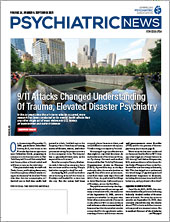Although the Food and Drug Administration’s approval of brexanolone for postpartum depression in 2019 offered hope to countless new mothers, it also came with a high price tag and logistical challenges—as treatment with intravenous medication requires multiple days in the hospital. An oral medication called zuranolone that acts on similar receptors as brexanolone may soon be available. A phase 3 trial revealed that women who took the once-daily medication for two weeks experienced rapid and sustained improvements of postpartum depression and anxiety compared with those taking placebo.
Zuranolone, like brexanolone, is manufactured by Sage Therapeutics, which sponsored this trial.
“For women with severe postpartum depression and suicidal ideation who require hospitalization, brexanolone would be a logical choice,” said Kristina Deligiannidis, M.D., an associate professor at the Institute of Behavioral Science at the Feinstein Institutes for Medical Research in Manhasset, N.Y., and principal academic investigator on this study. “But if we could offer a similar medication in an [oral] form…, we could greatly expand the benefit for ambulatory patients.” Deligiannidis has received grants and consulting fees from Sage.
That zuranolone could provide extended depression relief after a two-week dosing regimen would also be welcomed by many mothers who worry about breastfeeding while taking medication, she added.
The phase 3 trial involved 153 women aged 18 to 45 who had given birth in the past six months; all of the participants had been diagnosed with a major depressive episode without psychosis that began between the third trimester of pregnancy and four weeks postdelivery. The participants randomly received 30 mg of zuranolone daily or matching placebo pills for two weeks. These women were then monitored for one month after they stopped taking zuranolone or placebo. Assessments of maternal depression, anxiety, and overall functioning were taken at days 3, 8, 15, 21, and 45. The primary outcome was change in depressive symptoms from baseline to day 15, as measured using the 17-item Hamilton Rating Scale for Depression (HAMD-17).
By day 15, HAMD-17 scores in women receiving zuranolone fell by 17.8 points compared with 13.6 points in the placebo group—a difference that the authors noted was statistically significant. Noticeable differences in HAMD-17 scores between women taking zuranolone versus placebo were evident at day 3 and remained throughout the trial. At day 45—one month after the women had stopped taking either zuranolone or placebo—53% of the women in the zuranolone group were in remission (defined as a HAMD-17 score of 7 or less) compared with 30% of women in the placebo group.
Deligiannidis told Psychiatric News that the secondary outcomes for zuranolone were also quite encouraging. Scores on the Hamilton Rating Scale for Anxiety dropped by over 16 points by day 15 in the zuranolone group, compared with a 12-point drop in the placebo group, for example. “These improvements in patient anxiety were rather stunning and meaningful given how often symptoms of depression and anxiety overlap in postpartum illness,” she said.
The results also showed zuranolone was associated with strong improvements in measures of maternal functioning, including how well mothers felt they were bonding with their babies and were meeting their self-care needs. “These measures were important to look at because they show that the symptom improvements are related to meaningful changes in these mother’s lives,” she said.
The most common side effects included drowsiness, headache, and dizziness, and the effects were mostly mild or moderate in severity. Critically, no women experienced a loss of consciousness, which has been associated with brexanolone infusions. There was also no indication of any withdrawal symptoms after the women had stopped taking zuranolone.
Jennifer Payne, M.D., vice-chair for research in psychiatry and neurobehavioral sciences at the University of Virginia and an expert in women’s mood disorders, praised these study findings but noted the results open a host of new questions.
“It’s wonderful that zuranolone shows long-lasting effects, but it doesn’t last forever,” she said. “We need to figure out optimal dosing schedules and whether this medication will still be effective for women outside the postpartum window.” (Sage is also testing zuranolone for major depression in adults; a recent phase 3 trial showed 50 mg of daily zuranolone was superior to placebo, but the effects began to wane after two weeks.)
Other questions offer more excitement, noted Payne, who was not involved in these trials. “Imagine the benefits this medication might have at the start of pregnancy,” she said. “Women at risk of depression could take a two-week dose and try to conceive without the worries of their antidepressant causing any harm.”
Deligiannidis is participating in a second phase 3 trial that is testing the effects of daily 50 mg doses of zuranolone in women with postpartum depression. This trial is expected to be finished by the end of 2021. ■
“Effect of Zuranolone vs Placebo in Postpartum Depression: A Randomized Clinical Trial” is posted
here.

